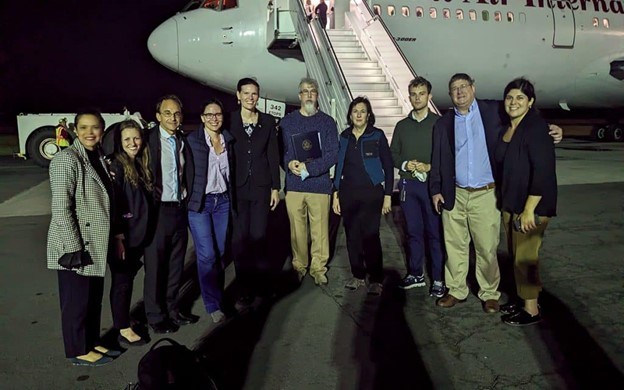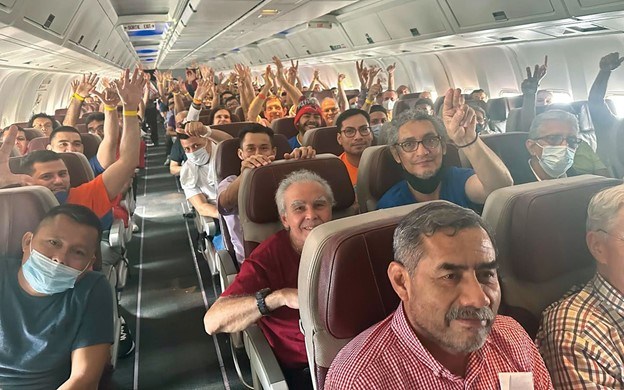When 222 Nicaraguan political prisoners were released

Photo: Mileydi Guilarte
In February 2023, 222 political prisoners were spirited to the United States from Nicaragua. Here’s the story of that unforgettable freedom flight.
By Kate Applegate* (Confidencial)
HAVANA TIMES – The plane took off after midnight, mostly empty. Sitting in a largely vacant cabin, 10 U.S. Civil Service and Foreign Service officers chatted, listened to music, and tried to calm their nerves. One moved back to an empty seat to pray. Two days earlier, most had had no idea what was about to unfold. Lance Hegerle, then deputy director for Central American affairs at State, had reached out cryptically, inviting colleagues on a mission with the barest of details: Spanish speakers. Plane travel. Diplomatic passport. Twenty-four hours.
Just before takeoff from a naval base in Norfolk, Virginia, late on Feb. 8, 2023, the team learned their full mission. It sounded more Hollywood than HST. They would leave Norfolk Naval Station on a USAID-funded jet, land in Managua, pack the plane with some 200 political prisoners pulled hours earlier from their jail cells, and spirit them to the United States, all in a matter of hours.
The mission was unclassified, but lives were at stake. Loose lips could sink the trip, condemning the political prisoners to continued imprisonment under the regime of Daniel Ortega and his wife, Rosario Murillo. Many political prisoners had spent years behind bars. The plan to free them came about in a matter of days, after long months of backdoor diplomacy. It came to fruition on Jan. 29, when Nicaraguan Foreign Minister Denis Moncada posed an unexpected question to then-Ambassador Kevin Sullivan, who had led U.S. Embassy Managua since 2018. Would the United States accept all the political prisoners from Nicaragua?
A flurry of activity ensued. Ambassador Sullivan boarded a plane to Washington to rally the interagency response, entrusting Chargé d’Affaires Carla Fleharty and a tiny embassy team to secure regime agreement on logistics, timing, and assurance that only prisoners who freely consented would leave for the United States.
Negotiations with the regime were touch and go until the last minute, when the ambassador overcame a major disagreement that had threatened to derail the entire operation. With that phone call over, Operation Nica Welcome was a go.
While the plane winged its way from Norfolk to Nicaragua, an embassy team assembled in Managua. Chargé d’Affaires Fleharty, Acting Deputy Chief of Mission Ryan Reid, Information Officer Gaby Canavati, Acting Consular Chief Katie Jonas, Acting Regional Security Officer Will LaChance, and Defense Attaché Lt. Col. Dennis Rhoan climbed into a motor pool SUV, toting a large plastic crate stuffed with more than 220 freshly printed Nicaraguan passports. For prisoners with no prior passport, the regime had substituted mug shots.
About half the group had been arrested in 2018, when thousands of Nicaraguans protested proposed changes to social security. Security forces squelched dissent with live ammunition, injuring a few hundred people and arresting hundreds more. Over the coming months, security forces killed more than 300 protestors—some, newspapers showed, had been targeted by regime snipers.
The regime rounded up another wave of prisoners as the 2021 election loomed. Every presidential contender was arrested, seven candidates in all. Journalists, business figures, even Sandinistas who fought beside Ortega for decades, but later broke with him, were jailed. Many landed in the infamous “El Chipote” prison, in solitary confinement, without access to lawyers or loved ones.
The crackdown hit close to home for US diplomats. As Managua’s political chief from 2020 to 2022, Hegerle remembers hosting Pedro Joaquín Chamorro, a journalist and politician, and his wife for wine and cheese one night in June 2021. The next day, Chamorro texted Hegerle just before his arrest. Then Chamorro’s WhatsApp line went silent.



